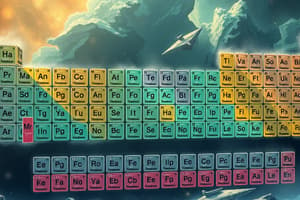Podcast
Questions and Answers
How did chemists begin to organize the known elements?
How did chemists begin to organize the known elements?
used the properties of elements to sort them into groups
How did Mendeleev organize his periodic table?
How did Mendeleev organize his periodic table?
by increasing atomic mass
What is the periodic law?
What is the periodic law?
when elements are arranged in order of increasing atomic number, there is a periodic repetition of their properties
How is the modern periodic table organized?
How is the modern periodic table organized?
What are metals?
What are metals?
What are nonmetals?
What are nonmetals?
What is a metalloid?
What is a metalloid?
What are the three broad classes of elements?
What are the three broad classes of elements?
What is an alkali metal?
What is an alkali metal?
What is an alkaline earth metal?
What is an alkaline earth metal?
What is a halogen?
What is a halogen?
What information can be shown in a periodic table?
What information can be shown in a periodic table?
What is a noble gas?
What is a noble gas?
What is a representative element?
What is a representative element?
What is a transition metal?
What is a transition metal?
What is an inner transition metal?
What is an inner transition metal?
How can elements be classified based on electron configuration?
How can elements be classified based on electron configuration?
What is atomic radius?
What is atomic radius?
What are the trends among the elements for atomic size?
What are the trends among the elements for atomic size?
What is an ion?
What is an ion?
What is a cation?
What is a cation?
What is an anion?
What is an anion?
How do ions form?
How do ions form?
What is ionization energy?
What is ionization energy?
What are the trends among the elements for ionization energy?
What are the trends among the elements for ionization energy?
What are the trends among the elements for ionic size?
What are the trends among the elements for ionic size?
What is electronegativity?
What is electronegativity?
What are the trends among the elements for electronegativity?
What are the trends among the elements for electronegativity?
What is another name for representative elements?
What is another name for representative elements?
What is another name for transition metals?
What is another name for transition metals?
What do cations form?
What do cations form?
Study Notes
Organization of Elements
- Chemists initially sorted known elements based on their properties into groups.
- Mendeleev's periodic table was organized by increasing atomic mass.
- Modern periodic table organizes elements by increasing atomic number.
Periodic Law
- When elements are arranged by increasing atomic number, their properties repeat periodically.
Classification of Elements
- Elements are classified into three broad categories: Metals, Nonmetals, and Metalloids.
- Metals are conductive, ductile, malleable, and shiny.
- Nonmetals possess properties opposite to metals.
- Metalloids share characteristics of both metals and nonmetals.
Specific Groups of Elements
- Alkali Metals: Found in Group 1A of the periodic table.
- Alkaline Earth Metals: Located in Group 2A.
- Halogens: Nonmetals in Group 7A.
- Noble Gases: Elements in Group 8A.
- Representative Elements: Found in Groups 1A through 7A.
- Transition Metals: Group B elements displayed in the periodic table.
- Inner Transition Metals: Elements in lanthanide or actinide series.
Information in the Periodic Table
- Features symbols, names, and atom structure information for each element.
Electron Configuration Classification
- Classification based on electron configuration includes noble gases, representative elements, transition metals, and inner transition metals.
Atomic Properties
- Atomic Radius: Defined as half the distance between nuclei of atoms in a diatomic molecule.
- Atomic size trends: Increases down a group and decreases across a period.
Ion Formation
- Ions are charged atoms or groups of atoms.
- Cations: Atoms or groups with a positive charge.
- Anions: Atoms or groups with a negative charge.
- Ions form through the transfer of electrons between atoms.
Ionization Energy
- Ionization energy is the energy needed to remove an electron from an atom.
- Trends in ionization energy: Decreases down a group and increases across a period.
Ionic Size Trends
- Ionic size increases down a group and cations and anions typically decrease in size across a period.
Electronegativity
- Electronegativity measures an atom's ability to attract electrons in a compound.
- Electronegativity trends: Generally decreases down a group and tends to increase across a period for representative elements.
Group Synonyms
- Representative elements are also known as Group A Elements.
- Transition metals are also referred to as Group B Elements.
Formation of Cations
- Cations are formed to achieve electron stability.
Studying That Suits You
Use AI to generate personalized quizzes and flashcards to suit your learning preferences.
Description
Test your understanding of the Periodic Table concepts in Chemistry Chapter 6. This quiz covers how elements are organized, Mendeleev's contributions, and the periodic law that governs the properties of elements. Challenge yourself with these flashcards to reinforce your knowledge!




